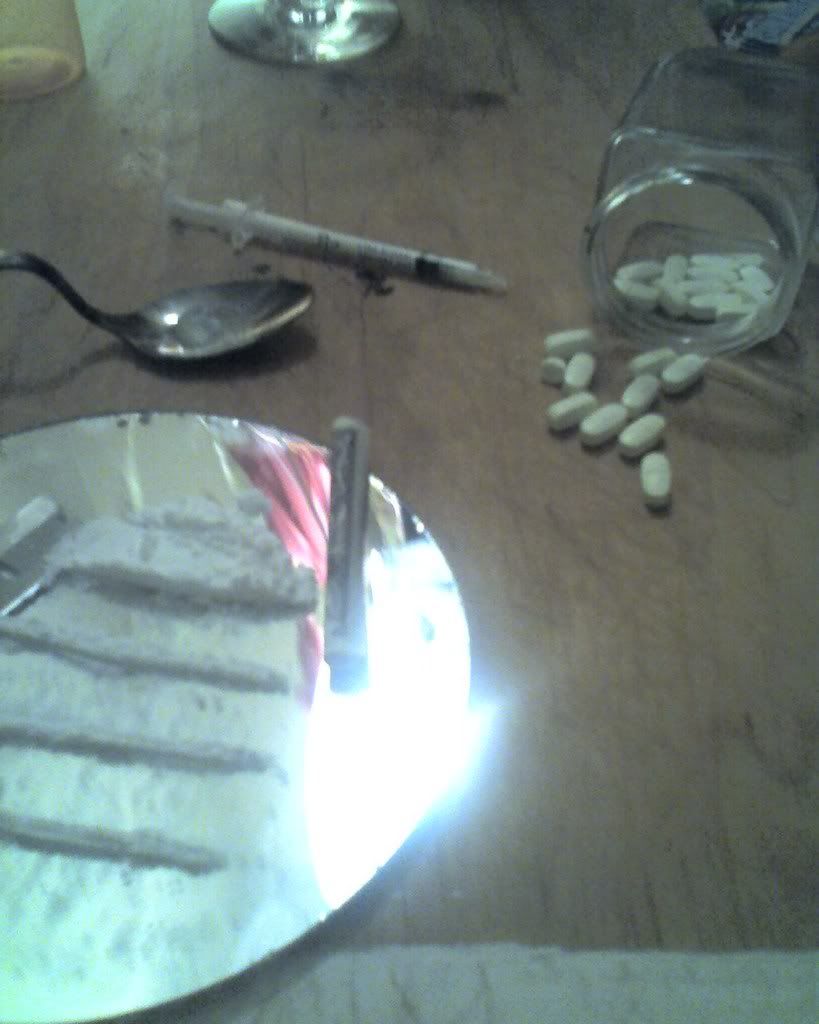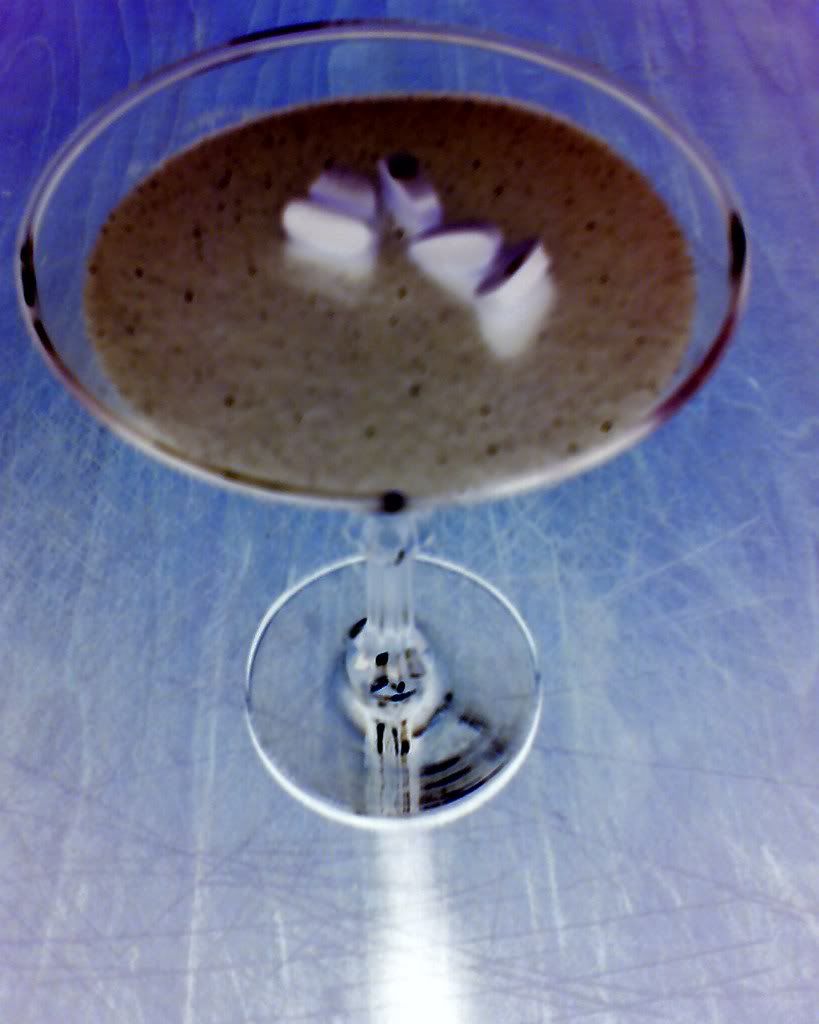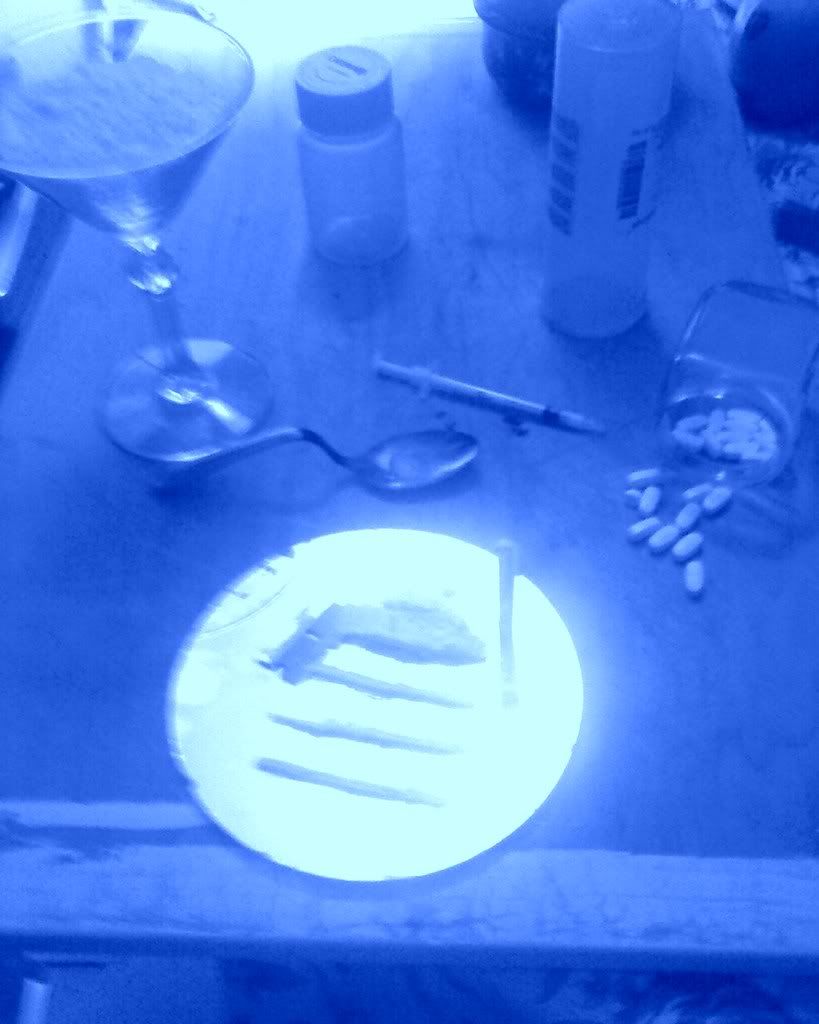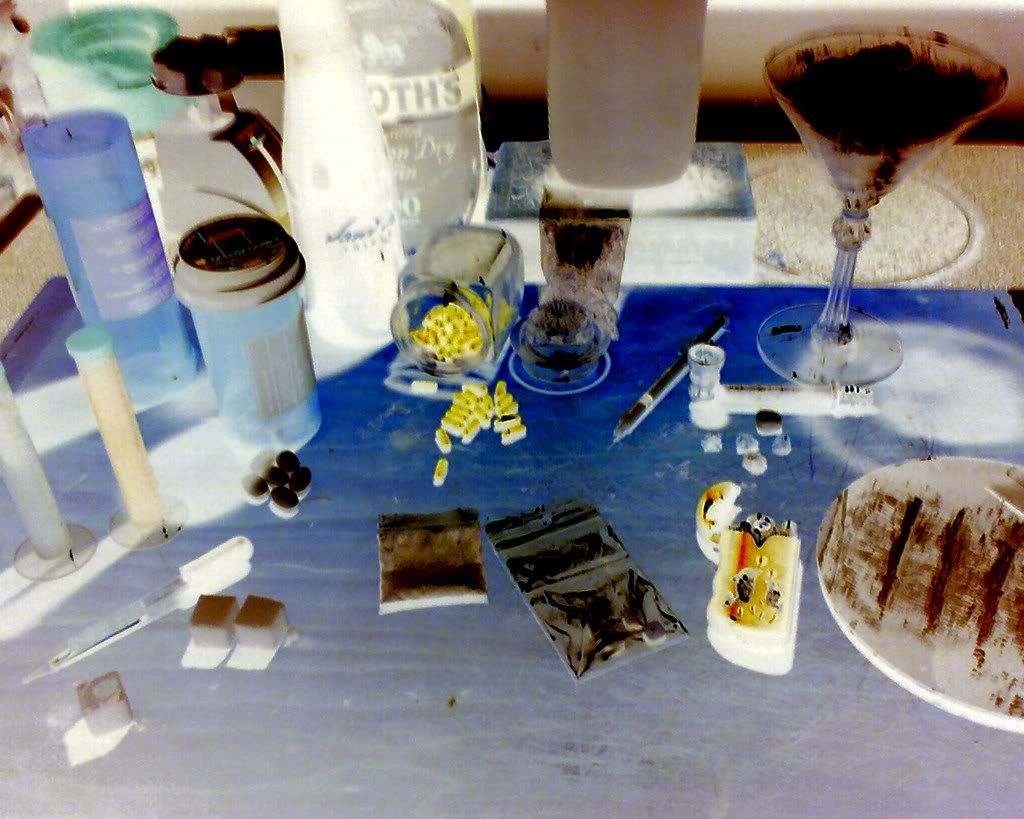
The history of recreational drug use in the 20th century can be read in the lyric sheets and sonic signatures of popular music, from the opiate cloud over the jazz age, to the amphetamine-juiced birth of rock n' roll, to the psychedelic fuel of rave culture. Music has served as a newscast of the rise and fall of various drug trends, the lyrics and sound reflecting the In Crowd's current substance of choice, either advertising its joys and benefits or warning of its dark side. For decades, songs hyped the potential of various drugs for mind expansion, the famous Aldous Huxley beat about opening new doors of perception in one's sensory experience, with drugs as the tool of choice to "turn off your mind, relax, and float downstream."
Lately, however, drug culture has made a significant shift, progressing like an up-and-coming band from the youth-dominated underground to the wide-demographic, commercialized mainstream. Even the term "drug" has changed in meaning; there used to be an easy distinction between "drugs," those seductive and evil things that will ruin your life, and "medicine," what you take for a cold or a hangover. Nowadays, the drug business isn't an amorphous boogeyman the government is fighting an endless and expensive war against; rather, it's one of the largest industries in the world.
Thus far in the 21st century, the cutting-edge intoxicant class has not been uppers or downers or opiates or psychedelics, but the drugs you pick up at your local Walgreen's. DARE ads have started to focus their scare-mongering on the abuse of prescription drugs, meaning that the trend has been going for at least five years now-- hell, I remember other high school kids trying to snort their Ritalin in the mid-1990s. With the flood of medications on the market to help with everything from depression to impotence, it was only a matter of time before people began to devise recreational off-label use for all these powerful substances, and songs about abusing cough syrup, Vicodin, and OxyContin were soon to follow.
But perhaps an even more interesting phenomenon is the increasing frequency of songs about legitimate use of pharmaceuticals. Depression has kept pace with drugs on the song-topic charts, particularly in the arena of alternative/indie rock, where mood disorders have long been the muse for many a mopey artist. With depression, and mental illness in general, becoming less taboo among younger generations, and with prescription-drug options for treatment of depression becoming increasingly common, it's logical that the language of brain physiology and pharmaceutical remedies would gradually start to infiltrate lyrics. Recent albums from Cloud Cult and Of Montreal face these issues directly and unflinchingly, dissonantly placing reflections on brain function and anti-depressants into catchy, infectious pop.

Legal drugs have been making rare appearances throughout the history of rock n' roll-- even back to its earliest days. However, the early rock opinion toward prescription medication was less than favorable, perhaps best represented by the Rolling Stones' 1966 song "Mother's Little Helper". By castigating a middle-aged protagonist for popping Valium pills like candy to get through the day and forget the horrifying "drag" of getting old, the Stones appear somewhat oblivious to their own hypocrisy; after all, within the year, Brian Jones, Mick Jagger, and Keith Richards were all arrested for drug possession. This demarcation between drugs illegal and legal reflected the spirit of the time, as hip youngsters were expected to experiment with pot and LSD while their mothers were supposed to deal with their boredom via non-pharmaceutical means, like, you know, cooking and cleaning.
The dismissal of prescription drugs in "Mother's Little Helper" also ignored the component of the 60s drug scene, in England especially, that was reliant upon drugs developed and intended for medical use. Before moving on to "harder" drugs like heroin and LSD, many musicians first experience with illicit substances came in the form of uppers or downers, many of which were easily available on the legal market. Amphetamine, which drove the mod scene of the early 60s, was sold under trade names like Benzedrine, Preludin, and Dexedrine and hyped as a remedy for everything from schizophrenia to night blindness. Where speed is popular, so too are downers, and sure enough the 60s were also a boom period for depressants-- legal and otherwise. Valium (diazepam) was approved for use in 1963, joining the long used-and-abused barbiturates as the sedatives of choice in Britain and America. Not for nothing are many of the "pusher" songs of the 60s about quasi-legal drug dispensers like The Other Half's "Mr. Pharmacist", (later covered by the Fall) or the Beatles' "Doctor Robert".
But as hallucinogens began to capture the underground's attention in the late 60s, doing the same drugs as your parents fell out of fashion; here the key line is the "White Rabbit" admonition, "One pill makes you larger and one pill makes you small/ But the ones that mother gives you don't do anything at all." This proclamation marked the beginning of prescription drugs' long absence from popular music. While recreational use of uppers and downers certainly didn't go away, and speed especially played vital roles in the development of the punk and metal scenes, dropping trade names into songs was no longer common practice.
Singing songs about being blue, of course, didn't go out of fashion either, but musicians struggling with depression in the 70s and 80s were more likely to celebrate or incorporate the psychotherapy terminology of the day. Arthur Janov's primal therapy, the idea of making psychological process through reliving emotional pain, strongly influenced John Lennon's Plastic Ono Band period and inspired the naming of the band Tears for Fears-- not to mention, duh, Primal Scream. In other songs, skepticism about the latest psychiatric techniques reigned, like the Ramones' "Psycho Therapy" (which mentions the barbiturate Tuinal), while the imagery of mental illness became cartoon fodder for heavy metal album covers.
Beginning in the late 80s, the pharmaceutical industry began to grow at an exponential rate, on the back of wonder drugs like Zoloft, Propecia, Viagra, Xanax, Wellbutrin, and many more. Rather than the humble, utilitarian image of familiar brands of over-the-counter drugs such as aspirin and prescription medications like penicillin, these drugs came with full advertising campaigns, many marketed "direct to consumer" in endless soft-focus "ask your doctor if you need _____" magazine ads and television spots. Suddenly, people outside of the medical community became well-versed in the differences between Vioxx and Valtrex, and many pharmaceuticals began to accrue branding power in the league of stalwarts like Coca-Cola and McDonald's; everyone now knows what the "little blue diamond" is.
No surprise then that the increasing cultural visibility of prescription drugs led to more frequent appearances of these substances in popular music. Perhaps the first big hit in this vein was Nirvana's "Lithium", released as a single in 1992; lithium compounds have been used to treat symptoms of manic depression since the late 19th century. While Kurt Cobain's lyrics don't directly address the medication (did he ever directly address anything?), they do appear to reflect the constantly shifting moods and emotions of someone suffering bipolar disorder, and the song's popularity, solidified the connection between mental illness and element #3 in teenagers everywhere.
Since "Lithium", scores of songs have used prescription drugs as a title or a lyric; punch one brand into AllMusic or some other search engine, and you'll find dozens of songs, covering virtually any genre but mainly appearing in the last 10 years. As one of the first and most popular drugs in this relatively recent prescription-drug class, it's no surprise that Prozac is the headliner in this class, lending its Eli Lilly-derived name to 110 songs. Strangely, nearly all of these songs are terrible, with luminaries like Vanilla Ice (in his rap-rock makeover guise), MxPx, the Mr. T Experience, and Dokken all using the drug to their own ends. Most misunderstand the drug's function or purpose, and some Prozac homilies never even mention the drug, like Denali's "Prozac", simply going for impressionistic descriptions of the depressive state the drug is intended to treat. On the other hand, Zoloft, Pfizer's version of the same selective serotonin reuptake inhibitor (SSRI) class as Prozac, appears to inspire strangely humorous songs, like Ween's psychedelic-preset commercial jingle on Quebec or the Drive-By Truckers' old-fashioned country stomper about an over-medicated family.
Most of the above songs deal with legal, prescribed use of pharmaceuticals; it's hard to get high off antidepressants. But there has also been a rise over the last few years in songs about recreational use of medication designed for treatment, reflecting societal trends; the 2006 edition of the annual
"Monitoring the Future" survey of teenage drug use saw an increase in the abuse of prescription drugs despite decreases in most other drug classes. Vicodin is a popular pill in this regard, with Eminem (who has a tattoo of a Vicodin pill on his arm) perhaps the most frequent proponent, name-dropping the drug in several songs, including "Kill You" and "Under the Influence". The drug has also popped up in songs by metal group Atreyu and indie songstress Terra Naomi, while El-P opts instead for the opiate-based painkiller "Oxycontin" in his two different songs of the same name.
However, the predominant hip-hop medical substance trend of late has undoubtedly been the appropriation of cough syrup, preferably the kind laced with codeine that's only available via prescription in the U.S. Having picked up a multitude of slang names and mixture recipes, such as lean, purple drank, and sizzurp, the substance has inspired not just individual songs but arguably an entire hip-hop genre, the "chopped-and-screwed" ultra-slow remix style developed by Houston's DJ Screw (who may have died of side effects from the drug in 2000). Three 6 Mafia's "Sippin' on Some Syrup" was the first song to hype the drug beyond a regional audience, and the drug combination has since popped up in songs from artists like Paul Wall and Mike Jones, many of which contain backing tracks that simulate the slow-motion effects of the substance.
Pills are also a frequent character of many drug-themed songs, though again it's hard to tell if the capsules in question are of the pharmacist variety or of the uppers/downers type. It's a pretty safe bet that any 60s-70s song (cf. The Who's "I've Had Enough" or 20/20's "Yellow Pills") is referring to the kind of pills you don't buy at the corner drug store, but recent examples from the emo side of the world are more clinical. Panic at the Disco's "Nails for Breakfast, Tacks for Snacks" talks about "prescribed pills/ To offset the shakes/ To offset the pills/ You know you should take," and Bright Eyes' "Loose Leaves" mentions "prescription pills/ Well I take two a day to make my brain behave."

The general thread through most of these songs is that the prescription drug in question is not being used literally; it's often meant to stand in as a signifier for depression, or as a symbol for the perceived overmedication of modern society. However, 2007 has already dealt out a series of songs that address prescription drug use more directly, connecting the dots between the actual mechanisms of these drugs and the neurochemical basis for moods and emotions. It's a trend that reflects the growing awareness of neuroscientific basics among non-scientists in general, and opens new philosophical avenues for the cultural discussion of musical mainstays like depression and love.
It's understandable that most songs don't attempt to tackle the actual neurobiological mechanisms of illegal and legal drugs, given that it's pretty hard to find a word that rhymes with serotonin. Due credit then to exceptions like the Talking Heads' "Drugs (Electricity)", which (probably unintentionally) discusses an unnamed substance's effects in terms of the electricity that underlies neural communication, or Murs & Aesop Rock's "Happy Pills", which actually successfully name-drops Klonopin and serotonin reuptake inhibition-- though that's the wrong mechanism for Klonopin, which is an anti-anxiety medication. But as it becomes common knowledge that chemical neurotransmitters play a role in regulating mood and emotion, enough so that these mental states can be manipulated with a simple pill, it follows that songs would be written about the reassuring and/or disturbing reactions to this information.
No recent song encapsulates this phenomenon quite like Of Montreal's mouthful-named single "Heimdalsgate Like a Promethean Curse" from Hissing Fauna, Are You the Destroyer? Amidst an album where songwriter Kevin Barnes evocatively narrates his fluctuations between depression (the agoraphobia and lethargy of "A Sentence of Sorts in Kongsvinger") to hypersexual mania ("Bunny Ain't No Kind of Rider"), "Heimdelsgate" is a reflection on bipolarity set to discordantly peppy keyboards. "I'm in a crisis/ I need help/ C'mon mood shift/ Shift back to good again," Barnes pleads, but it's not directed at the usual abstract depression boogeyman, but rather a concrete source of his emotional instability: his own neurotransmitters.
Chemicals, don't strangle my headChemicals, don't make me sick againI'm always so dubious of your intentLike I can't afford to replace what you've spent
Chemicals, don't flatten my mindChemicals, don't mess me up this timeThough you bait me way more than you shouldAnd it's just like you to hurt me when I'm feeling good
In an interview with Pitchfork contributor Stephen Deusner for the
Memphis Flyer, Barnes described his mindset during the making of Hissing Fauna: "I'd gone through a pretty heavy period when I was writing it and recording it. Kind of my first real experience with chemical depression and serious anxiety and paranoia and what might be qualified as mental illness." "Heimdelsgate", Barnes told
Magnet magazine was about how "you can't really control the chemicals in your brain, and sometimes there's nothing you can do to keep it together." While no songs on the record directly address prescription medication, the singer does credit antidepressants with the making of the album: "The real issue was a chemical thing, so when I finally got on medication, that balanced it out. So that helped me have a better perspective on things and helped my relationship with my wife and helped me through [the album]."
On the other hand, in an interview with the
San Diego City Beat, Barnes also blamed antidepressants for the somewhat ill-received sale of "Wraith Pinned to the Mist" as an Outback Steakhouse commercial: "When Outback approached me, I was in this really weird state of mind where I was so indifferent I didn't really care," Barnes says. "I was pretty heavily medicated with antidepressants that were pushing me in this weird direction. I was very indifferent, very detached. It was helping me with all this anxiety and paranoia and this crazy depression stuff, but it made me make a bad decision."
"Take Pills", from Panda Bear's Person Pitch, is a sample and loop-based swirl that fits squarely within the psychedelic-pop sound that his primary group, Animal Collective, is known for. Thick with reverb, dreamy harmonies, and unusual found-sound stimuli, it's a track with all the markings of a "drug song." So why does the mantra of the final section begin with "I don't want for us to take pills anymore?" In a recent interview with
Dusted Magazine's Rob Hatch-Miller, Panda Bear (Noah Lennox) clarified:
"That song is pretty explicitly about anti-depressant drugs, not more recreational kinds of drugs. I was on anti-depressants for a while and my mom continues to be on them. Melancholy and depression is kind of a theme in my family. The song is about appreciating what they did for me at the time but wanting to get off of them, and to try not to rely on them if I could. And that's not to say that I think nobody should be on them, like I said they really helped me out for a while. But for me personally I just wanted to try to get on with it, and it's kind of me talking to my mom about trying to get her off of them too. I used to see a psychiatrist and he was like, "You're going to have to be on these drugs for the rest of your life, it's just the chemistry of your brain." That kind of bummed me out, so I really wanted to prove him wrong. He was a nice guy, but he was wrong.
The song, then, acknowledges the utility of prescription medication as a temporary fix, but reflects discomfort with it being a permanent solution, a common obstacle facing people who are recommended to go on antidepressants. As a replacement for pills, Lennox instead recommends a sort of holistic type of advice, to "take one day at a time" and "only one thing at a time," the popular idea that a temporary amount of time on medication is enough to get one's brain chemistry sorted out, and that healthy living can stand in for pharmaceutical treatments.
A similar point of view is espoused by Cloud Cult's Craig Minowa, whose latest album The Meaning of 8 contains a number of tracks that use the terminology of neurochemicals and brain function in discussing emotion and depression. Minowa is more skeptical of his own experiences with antidepressants, which occurred after a personal tragedy:
"Shortly after my two-year-old son left the planet the doctors put me on some anti-depressants, because they were afraid I was going to try and follow my son to wherever it is he went to. The doctors thought they could fix my grieving by adjusting my brain chemistry with pharmaceuticals. I think there are instances where a person would be well suited for the need to ingest certain elements to balance their neurochemicals, but that was not one of them, so I got off those drugs after a few short weeks."
"I think many doctors freely prescribe these types of medications to deal with the negative effects of a mental problem, while they tend to completely ignore the causes. In my instance, my kid had just died. I needed to just cry for a long while and grieve, but the doctors thought it would be best to cover up those feelings with drugs. Our physicians need to get better at determining what is a mood problem brought on by a chemical imbalance, and a mood that is brought on by psychological trauma. Each of these should be treated in very different ways."
Thus, a song like "Take Your Medicine" off of The Meaning of 8 with its command:
You can take it in strideOr you can take it right between the eyesSuck up, suck upAnd take your medicineIt's a good day, it's a good dayTo face the hard things
is not about antidepressants, but about the more general experience of facing the sources of one's depression and adjusting brain chemistry without medication: "Take Your Medicine" is literally about conjuring up the strength to face the ugly things in yourself that most of us prefer to deny exist. In the case of this song, taking one's medicine is not about popping a pharmaceutical but is more accurately about having the guts to do some not-so-fun inner psychological work. Scientific studies have shown you can alter your brain chemistry simply by choosing to practice thinking in a different way. In that sense, 'taking your medicine' means having the discipline to break some bad mental habits and thereby changing your brain chemistry. Letting go of the inner monsters referenced in that song has helped me feel much better. But it wasn't an easy psychological process getting through that."
Minowa's interest in brain function doesn't stop with informed opinions about overprescription of antidepressants; with a background in biology, he's also read up on other influences upon neurochemical control of mood and emotion. "I've done some research into investigating the neurochemical reactions in the brain due to spiritual practices such as meditation and prayer. It's interesting to see that certain areas of activity in the brain of those on LSD coincide with the same activity one sees in a person in a deep state of meditation. The lesson you can take from that is either that you can take drugs like LSD because they will trick you into thinking you're enlightened. Or you can take the lesson that you can change your own brain chemistry and activity simply by having the self-discipline to exercise your brain in certain ways on a regular basis. I prefer the latter." So a song like "Chemicals Collide":
I was out paying close attentionOr was I lost inside my thoughtsThese days it's hard to tell what's outside from what's in my mindAnd oh god, it's beautifulInsatiableThe way our chemicals collide
appears to be, in part, using "chemicals" in the same way as Of Montreal's "Heimdelsgate": as an entity to take the blame and/or credit for the emotionally-charged way we perceive and exist in the world. But Minowa explains that's only one small aspect of the song's meaning:
"'Chemicals Collide' is really about all of the different chemicals that collide around to make the universe what it is. The brain is just one example of how these incredible elements mix together to make complex reactions. It's really no different than the rest of the universe. Mix different types of chemicals together and you'll get different colors or an explosion or a tasty recipe or a new energy source or even life. It's the same in the brain. I think the brain is just something we perceive reality through. The brain is not the essence of what we are. Some scientists want to claim they have it all figured out, and that the brain is the center of it all. But there's a whole lot more going on than they're comfortable accepting. In that sense, I'm not afraid of the fact that the brain is a mortal organ and that it can be persuaded to function differently when exposed to different chemicals. My brain is not me. It's just another one of my physical senses through which the real me sees."

This trio of artists appears to be heralding the next step in songs about prescription drugs and the mental illnesses they're designed to treat, both reflecting the complex societal viewpoints about these pharmaceutical advances and using medication as a gateway to dealing with emotion and mood in biological terms. The knowledge that we're to some extent the puppets of our brain chemistry is simultaneously disturbing and liberating to many people; nobody wants to hear feelings of love and spirituality reduced to the cold mechanics of neurotransmitters and receptors, but our modern ability to directly treat some of the underlying imbalances that cause debilitating mental illness is a clinical miracle, improving thousands upon thousands of lives worldwide.
While science may always remain a foreign language to songwriters and musicians, its influence upon music's native thematic territory of conveying and describing emotion is becoming increasingly hard to ignore. "Drug songs" of the past sought to translate the sensory experience of psychedelics or stimulants or opiates into musical form, to report on the powerful methods mankind has discovered or created to alter the way our brains work and play with the organ's interpretation of our surrounding reality. As we exist in an age where those tools of brain manipulation shift from mind-expansion to mind-maintenance and treatment, and the corner pusher is transformed into the corner pharmacist, it's only natural that our music follows suit, hymns to getting high changing into reflections on getting well.
This is a subject i could go on and on about, but wont. All pictures are By:
Jessica Beck. Thanks for reading.






